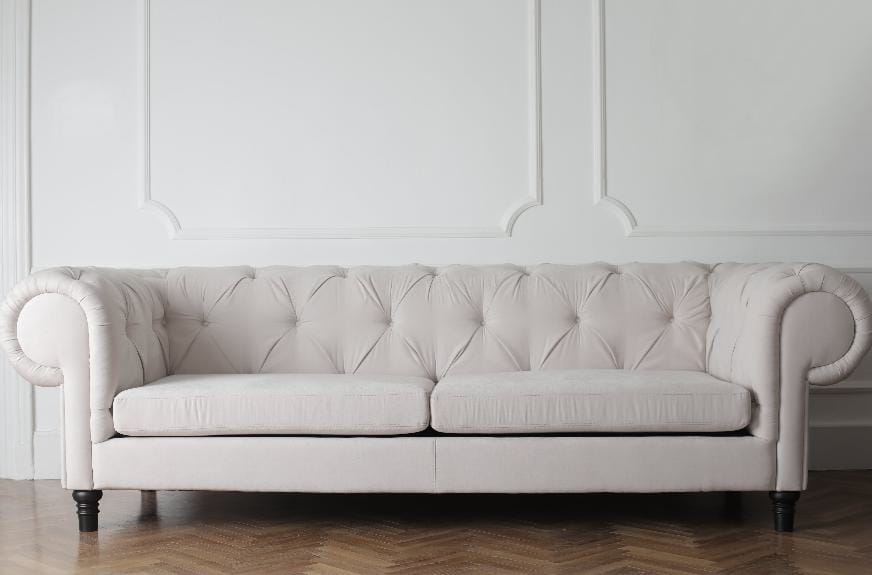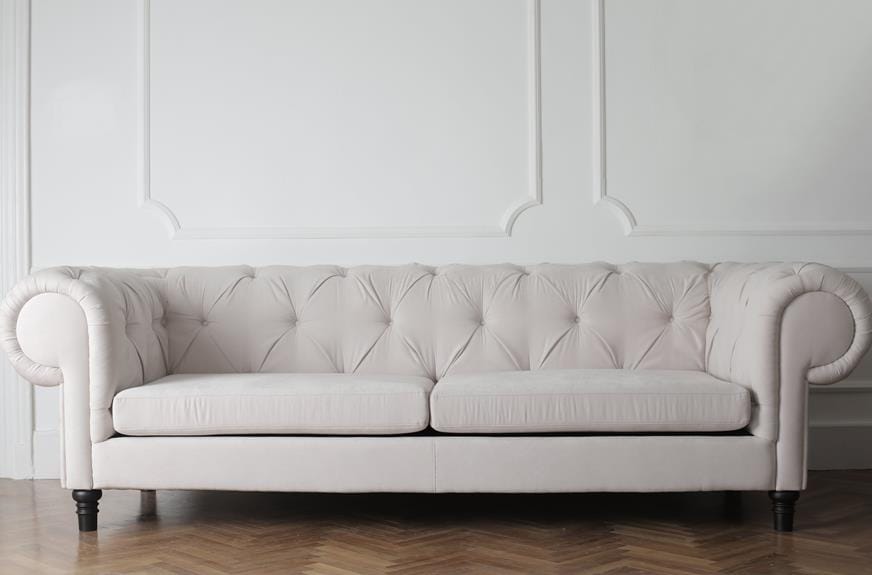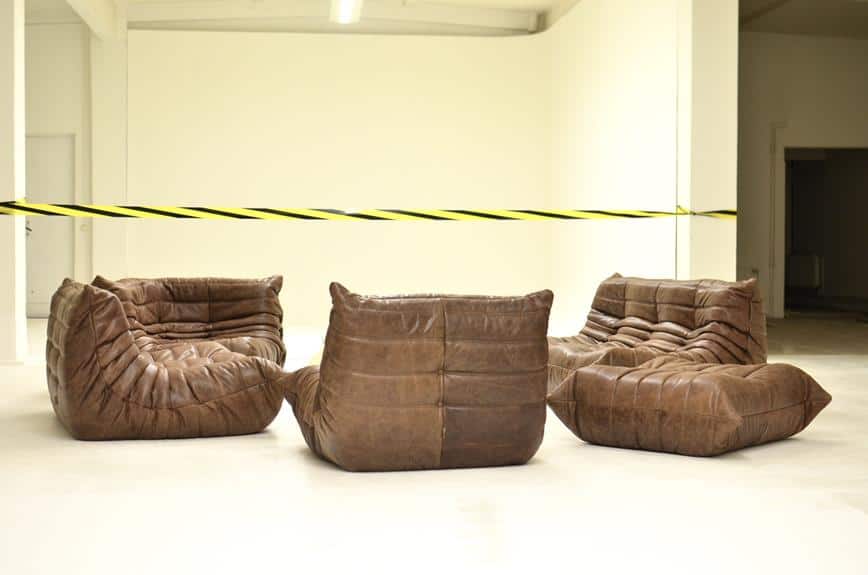Leather furniture may cause sweating due to its low breathability, which can trap body heat and moisture. The likelihood of sweating varies depending on the leather quality, with genuine leather generally being more breathable than synthetic versions. Treatments applied to the leather and its cleanliness can also impact moisture passage.
Let’s now examine the reasons leather furniture can lead to sweating and suggests ways to improve user comfort.
Leather Quality and Sweat
The quality of leather affects its breathability and the likelihood of sweating when used in furniture. High-quality leather usually has fewer treatments, allowing for better air circulation and less moisture buildup, reducing sweat. On the other hand, lower-quality leathers often have chemical treatments that block the pores, leading to more sweating, particularly with extended use or in hot climates.
Thicker leather can retain more heat, increasing the chance of sweating. Surface treatments like burnishing can also trap moisture, leading to discomfort. Additionally, darker leathers absorb more heat, which may cause more sweating than lighter colors.
It is important for both consumers and manufacturers to consider these factors for comfort and satisfaction with leather products, as there is a significant relationship between leather quality and the experience of sweating.
Temperature’s Role in Comfort
Temperature plays a vital role in the comfort of leather furniture. Leather can absorb and retain body heat, leading to potential discomfort and sweating if one sits for long periods. Unlike materials such as cotton or linen, leather is less breathable, which can result in heat accumulation.
The breathability and heat retention of leather can vary with its quality. High-quality, full-grain leather tends to be more breathable than lower-quality, heavily treated leather, which may have more sealed pores and less airflow, causing more heat retention.
Chemical treatments in the tanning process can also impact leather’s breathability and temperature regulation. These treatments may make leather more durable and stain-resistant but can also inhibit the material’s ability to let air and moisture pass through, leading to heat being trapped and increased sweating.
Regular cleaning of leather furniture is important to maintain its breathability. Accumulated dirt and oils can block the material’s pores, reducing air and moisture exchange. Clean leather is more likely to remain breathable, which helps in reducing sweat buildup and maintaining a comfortable temperature.
Chemical Treatments and Perspiration
Chemical treatments used in leather tanning can reduce the material’s breathability, leading to more sweating for people using leather furniture. These treatments improve durability and appearance but can also close off the pores in the leather, affecting its ability to absorb and release moisture. This makes leather surfaces less comfortable in warm conditions.
Substances like polyvinyl and synthetics are often added to leather, especially in car seats, to make it more durable. However, these coatings limit airflow, trap heat and moisture, and can cause sweating, even in cool settings.
Surface treatments such as burnishing, which presses and smooths the leather, can also limit ventilation. This compaction prevents moisture from escaping, trapping sweat against the person’s skin.
Faux leather, made from materials like polyurethane and vinyl, is even less breathable than genuine leather because it lacks natural pores, leading to more sweating.
Cleanliness and Sweating
Dirt and oils on leather furniture can lead to more sweating for those using it. As leather gets dirty, its pores get blocked, reducing airflow and making it feel warmer. This warmth makes the body sweat more to cool down.
To prevent this, it’s important to regularly clean and condition leather furniture. This helps keep the leather breathable and reduces sweating. Conditioning also keeps the leather soft and prevents it from trapping heat and moisture.
The thickness of leather also affects heat retention. Thicker leather, which is often more durable, can hold more heat, increasing the likelihood of sweating.
Regular care, including cleaning and proper maintenance, can improve the use of leather furniture and reduce sweating discomfort.
The Thickness of Leather
Thick leather is more durable but can retain heat, leading to potential discomfort and increased sweating if used for long periods. The tight packing of fibers in thick leather reduces air circulation, trapping body heat. Additionally, dark-colored leather absorbs more heat, which can also contribute to sweating.
The treatment of leather affects its breathability. For instance, leather treated with polyvinyl and synthetic materials, or surface treatments like burnishing, can make it less breathable and more likely to hold sweat against the skin.
Conversely, full-grain or top-grain cowhide leather is generally more breathable, as it does not undergo harmful chemical treatments, thus allowing better heat dissipation.
When choosing leather furniture, it’s important to consider both durability and comfort, particularly for use in warm environments for extended times.
Surface Treatments and Heat
Surface treatments like burnishing can reduce leather’s breathability, causing it to retain more heat and potentially leading to sweating. These treatments often smooth the leather’s surface and compress its pores, which affects its natural temperature and moisture regulation. As a result, leather might feel warmer against the skin and lead to discomfort due to increased perspiration.
Additionally, treatments that add synthetic materials or coatings, such as polyvinyl, can worsen heat retention by blocking air flow, which can make leather car seats and furniture feel hotter and less comfortable, particularly in warm conditions or after being used for extended periods.
The color of the leather also plays a role; darker colors absorb more heat than lighter ones, increasing the feeling of warmth and discomfort. Therefore, a combination of dark colors and certain surface treatments can make sweating more likely.
Influence of Leather Color
Leather color affects heat absorption and user comfort. Dark leather absorbs more heat, making it warmer and potentially causing users to sweat more, especially in sunlight. In contrast, light-colored leather reflects heat, staying cooler and reducing sweating during extended use.
When buying leather furniture, considering color for temperature comfort is advisable. Light shades enhance comfort for those susceptible to sweating or in hot climates, affecting the furniture’s comfort and practicality.
Preventing Sweat on Leather
To reduce sweating on leather furniture, it is advisable to choose leather types that resist sweat, such as those made from natural fibers like sheep’s wool, lambskin, and pigskin. These materials allow better airflow and moisture escape. Non-synthetic leather, which is less processed, also helps minimize sweating due to its porous nature.
Applying regular waxing treatments can create a moisture-repellent barrier on the leather without hardening it, unlike treatments that make leather resemble vinyl or plastic, which can trap heat and moisture.
For an alternative, consider vegan faux leather, which resembles real leather but offers greater breathability, potentially decreasing perspiration.




